P55 Extreme Overclockers: Check your sockets!
by Rajinder Gill on October 15, 2009 12:01 AM EST- Posted in
- Motherboards
We start with a picture.
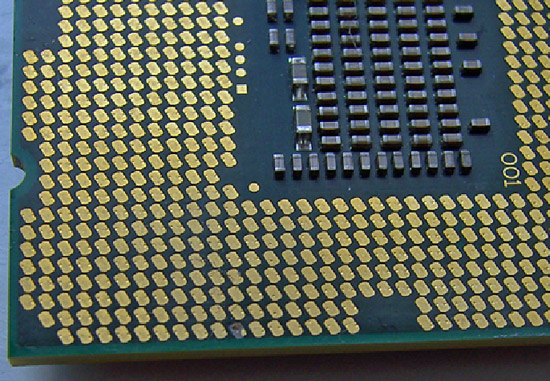
The picture above is after our Core i7 870 (LGA-1156) processor was overclocked up to 5.19GHz using our cascade with a -102° Celsius evaporator head temperature under full-load. Processor VCC power draw at these frequencies is around 160W (this is possible only due to subzero cooling), as measured with a clamp meter installed at the 12V EPS power lead. Study the pictures closely and you should notice something peculiar. Keep in mind it comes from a CPU installed in the same type of socket from a particular manufacturer.
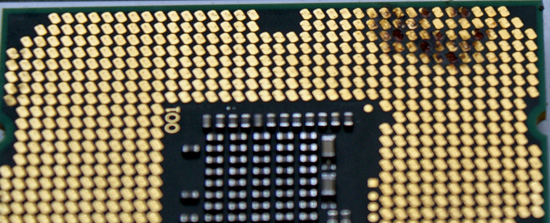
What happens after several extreme benchmark runs...
If you noticed something weird in the pictures then you understand the title of our article. We have what seems to be a potentially serious issue with proper socket loading on several P55-based motherboards when overclocking to the limit. We are of course not the only ones experiencing the problem as several of our overclocking peers have run into the same problem.
Normally we do not worry too much about mishaps during extreme overclocking testing as they are typically caused by factors outside of the supplier’s control. The overriding concern is that we have damaged every motherboard in our possession for the P55 overclocking (extreme) shootout as well as two very expensive i7/870 processors. These problems are the cause of a single component and are repeatable. As such, we thought we would provide details on current problems and will provide an update once all of the motherboard manufacturers affected have had a chance to properly respond.
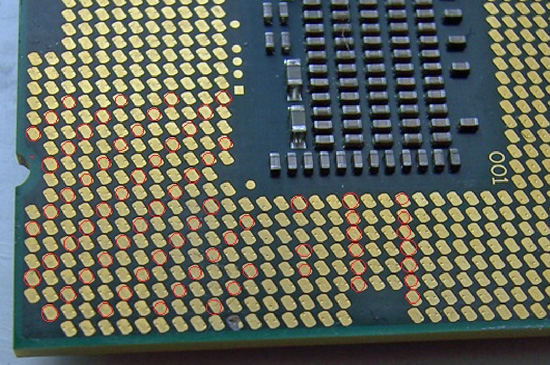
We draw your attention to the fact that the processor shown in this pictures exhibits signs of insufficient pin-to-pad contact (little to no contact) in what is a rather reproducible pattern with Foxconn manufactured 1156 sockets. As soon as an end-user mounts a CPU in a socket and latches the clamp mechanism, each pin should leave a notable mark on the associated pad.
We've marked locations where this does not seem to have happened, showing what appears to be a significant reduction in the number of VCC/VSS pins for proper power delivery, and certainly not at the right load line resistance. Damage resulting from highly overclocked use in these types of situations is not solely limited to the processor; let’s take a look at what happened to some of the motherboards in which these CPU were seated.
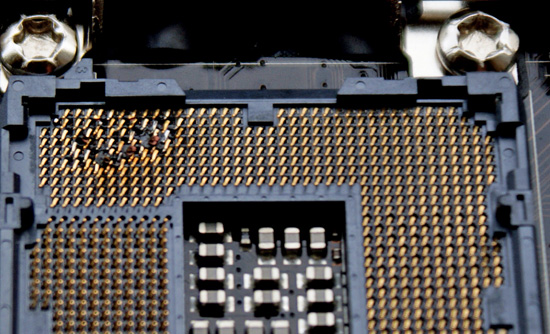
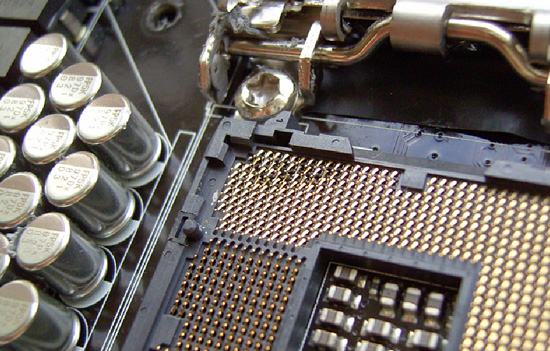
When Intel publishes socket specifications and design tolerances, it's up to component manufacturers to strictly adhere to them when designing, manufacturing, testing and ultimately selling their "compliant" components. Of course, that's not to say Intel could not have goofed when releasing their specification, leaving out a crucial tolerance or such. It could happen, but not likely. For the time being, let's assume that's not the case; seeing as how processors installed in sockets built by other companies have exhibited no such issue in testing to date.
At first glance, one might be inclined to think LGA-1156 based processors are intolerant of high-end overclocking, almost as if by design. This is correct to some extent; a quick glance at Intel’s white papers for socket 1156 CPU’s reveals that there are around 175 pads for VCC compared to over 250 for socket 1366 CPU’s. This means socket 1156 has around 66% of the current capacity of socket 1366, the caveat being that when overclocked, processors from both platforms draw similar levels of current.
When overclocked above 4GHz, processors from both platforms will draw around 15-16 amps via the EPS 12V rail to VCC, VTT and some of the other sub –system power rails under full 8 thread load from the Intel burn test (Linx). Assuming 85% PWM efficiency, we’re looking at power draw in the region of 130-140w to VCC on both platforms. The facts point toward tighter current handling tolerances for socket 1156 when compared to socket 1366, especially when it comes to non-connection of VCC/VSS power delivery pins.
Fortunately, we think we've been able to isolate pin to pad contact issues to one particular brand of parts. Physical inspection and end-user reports all but confirm the issues only affects sockets manufactured by Foxconn at this time. The only known alternative sockets in the wild are made by LOTES or Tyco AMP. We happen to have a couple of boards from EVGA using the LOTES/Tyco AMP sockets and MSI/DFI using the LOTES socket design, and thus far those boards have been issue free given highly similar operating conditions. In fact, we’ve managed to push our LGA-1156 processors further in heavy load tests on boards made using LOTES/Tyco AMP sockets than those made with sockets from Foxconn; something we’re not putting down solely to coincidence.
So far, EVGA is the only company we know that uses sockets exclusively from LOTES on their top-tier P55 boards - for example, the EVGA P55 Classified 200, model E659. This by the way may be the onus behind the decision to market the board’s “300% More Gold Content” socket statement as a purchasing option point. If you find yourself shopping for an EVGA P55 FTW, model E657, you've got a 50/50 chance of buying one with a Tyco AMP socket design (using a LOTES backplate), as opposed to one made solely with Foxconn's, the same goes for MSI and DFI who have batches of boards in the retail channel using LOTES sockets (although we're not entirely sure on socket specifics at this point). DFI told us earlier they have dropped usage of the Foxconn sockets completely until further notice. We hear the LOTES and Tyco AMP sockets are in short supply, which is probably why Foxconn's been able to fill the void in the market with what we believe to be a lower quality alternative for the extreme overclocker.
We took one of our damaged CPU’s and inserted it into one of the EVGA (LOTES/Tyco AMP) boards and took a few pics to show contact scoring and a side by side compare to the original Foxconn socket indents.
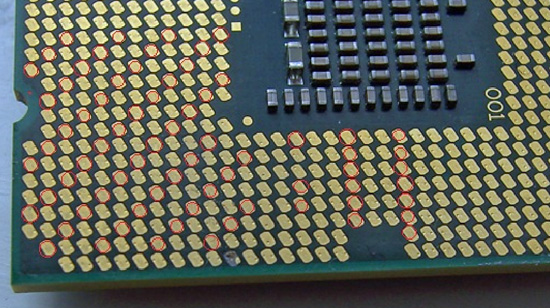
Foxconn 1156 Socket Installation
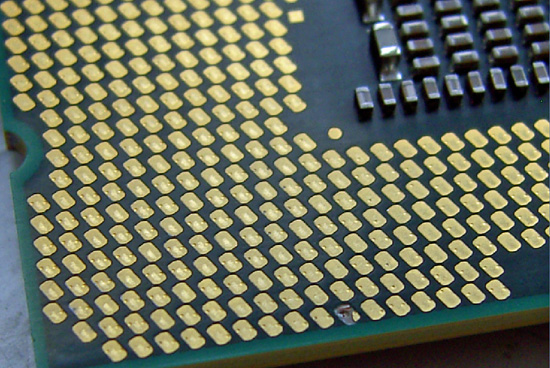
Tyco AMP / LOTES 1156 Socket Installation
Note how from a variety of angles certain pads show no evidence of contact from a Foxconn pin at all. Both the Tyco AMP and LOTES sockets have a larger pin/pad contact surface area leaving a slight scuff mark in the central area of each pad. In light of this, what we will say is that if you’re thinking of doing extreme overclocking on a board built using Foxconn's socket 1156, think again. Or, at least check your CPU for evidence of proper pin-to-pad contact.
We have not had any problems with air or water cooling overclocking up to 4.3GHz, although we do have a i5/750 that has developed a few dark pads after a thousand hours or so of constant overclocking. However, none of the boards have developed pin problems so we feel very safe in saying that any problems will probably occur only in extreme overclocking scenarios.
We also realize that partial responsibility for some of the less than acceptable CPU installations may be in fact due user installation errors. However, if users are screwing this up by doing nothing different than what they've always done when it comes to handling and installing LGA-type processors, then it's hard for us to find fault with the installer. Be aware of this situation and study the pin imprint on the CPU pads and make sure you have good contact on the VCC/VSS power delivery pads before pushing the system too hard.
















273 Comments
View All Comments
james jwb - Thursday, October 15, 2009 - link
You've gone against Foxconn now. If you live on a high floor, when you go home tonight stay away from the windows.Sandmen - Thursday, October 15, 2009 - link
The amount of current that can pass thru 2 contact surfaces is determined by the amount of surface contacts and the materials is made off, and this CPU and MB's are not design with contacts pins to handle high overcloking.Even with enough cooling to keep the core safe, eventually you will damage the points of contacts between the CPU and the MB.
Haven't you ever seen what happens to a regular electric outlet when you plug too many things to it?
May be a socket with more contact surface to each pin will help, but as it is rigth now, even when I can go higher with my i7-860, I just keep it at 3.5 GHz.
Sorry overclockers, try an i7-920.
Morbid666 - Friday, October 16, 2009 - link
- well said.loose connections in 110V/220-240V systems are the number one cause of domestic fires. here where cooling is so essential this type of contact is unjustified. the burns i see illustrated in above pictures are the same burns i see at work where mains cables melt like candle.
vshin - Thursday, October 15, 2009 - link
On a more ominous note, Newegg seems to be wiping cutomer reviews of certain motherboards that have had a spate of negative "DOA" entries. One example is the Gigabyte UD3 where there use to be 7-9 reviews with a couple DOAs but now they're all gone. I wonder if the problem is more pervasive than we think. It seems to me there have been a lot more DOA reports for the p55 launch than prior launches of new chipsets. Maybe all those DOAs are due to lack of contact with key pins.I suggest coating either the pins or the CPU with some kind of colored powder or other thin substance and then check to see if any residue is transferred to the other side after installing the chip. This will help differentiate whether the pins are making light contact vs no contact at all.
ClagMaster - Monday, October 19, 2009 - link
I noticed that too on the Gigabyte UD3R motherboard.Newegg will remove posts that it deems is irrelevant and/or excessively negative -- appearently at the behest of the manufacturer. I saw this done on a $1500 Core 2 Extreme QX9775 for the Skulltrail platform that had posts that complained was absurdly expensive. Most did not own this processor and gave it a poor or very poor rating.
wolfman3k5 - Friday, October 16, 2009 - link
NewEgg deletes and manipulates reviews. I buy allot of stuff, and almost every time that I've left a detailed review about a hardware failure, NewEgg shot me an email that it doesn't meet their guidelines. Not to mention that I've left a couple of reviews where I got screwed with Mail In Rebates (cough... by Gigabyte ...cough), and NewEgg deleted them. That's why this days you see so many dumb ass reviews on NewEgg, things like: "This 5870 pwns NVidia, final nail in the coffin...". But as soon as you give some detailed account of trouble, or say that NewEgg has some of the worst pricing and return policies, or their customer service has become unbelievably stupid, you're not going to get your review published, or if it slips trough, it will get deleted. NewEgg needs a good spanking from the Better Business Bureau, unfortunately they have grown large, so allot more people need to file complaints.All that being said, I kind of miss the point why people buy Sockey 1156 parts... Doesn't make much sense, and the savings aren't really there, unless of course, you're willing to put up with this crap.
PrinceGaz - Thursday, October 15, 2009 - link
I always preferred PGA as my first thought when LGA775 was introduced was "do spring loaded pins in the socket really make as good a contact with the CPU, as a socket which gripped the pins on the CPU?".I know that LGA allows for a greater pin-density than PGA, but PGA939 as used by the Athlon 64 wasn't unacceptably large (roughly halfway between LGA1166 and LGA1356).
Kibbles - Thursday, October 15, 2009 - link
Is there a way to see which manufacturer you got? Do they look any different?yacoub - Thursday, October 15, 2009 - link
Good to know.Btw, do you guys still have P55 motherboard reviews coming, separate from the super overclocker guide article?
Rajinder Gill - Thursday, October 15, 2009 - link
I've got a 4 board OC showdown in the midst (although it's using sub zero) - which has been delayed mid testing because of this socket issue. Kinda makes everything moot for me..lolI think Gary may have a couple of full comprehensive reviews coming though I'm not sure of the specific board models.